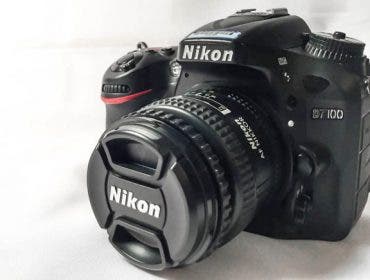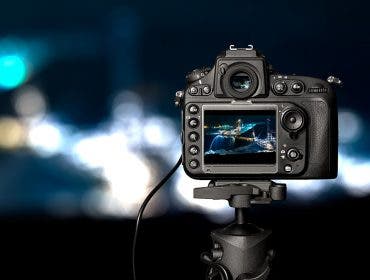ound $2,999.95 starting late July, the 12.1MP D700 is the first meaningful competition to the full-frame Canon 5D.
The D700 is built around what Nikon’s US press release describes as a “Nikon-original” FX-format CMOS sensor, although the European press release infers the sensor was made by Sony exclusively for Nikon. In any event, the pixels on this 12.1MP sensor measure a relatively generous 8.45 microns resulting in claimed low signal-to-noise ratio and wide dynamic range for ISO 200-1600. ISO can be expanded to 100-25,600. Much of the technology and features found in the D700 can also be found in some form in its pro sibling, the D3, and the serious enthusiast-oriented D300. The D700 is significantly lighter and smaller than the D3 but maintains many of the D3’s features. The D700 will be available either body only or bundled with the AF-S VR Zoom-Nikkor 24-120mm f/3.5-5.6 G IF-ED for around $3,599.95.
Key features:
- Nikon F lens mount
- 51-point AF
- 3D focus tracking
- 2 live-view shooting modes
- 3-inch LCD monitor
- Scene Recognition
- First full-frame dust reduction
- Claimed 0.12 second start-up
- 0.4 millisecond shutter lag
- 5 fps full-resolution JPEG burst rate
- 8 fps full-resolution JPEG burst rate with MB_D10 battery pack
- Compatible with next-gen high-speed UDMA CF cards, write speed up to 35MB/s
- 1005-pixel RGB light sensor for AE, AWB, AF calculations
- Eye-level pentaprisim viewfinder provides 95 percent coverage
- High-strength magnesium alloy body
- Fully compatible with G and D AF Nikkor lenses%3B mostly or partly compatible with DX, AI-P, non-CPU AI and non-G or D Nikkor lenses.
Nikon has posted a full PDF brochure for the D700, including complete specifications, illustrations and details, in its website, which you can download here (10MB).
For details, read the Nikon USA press release:
THE AGILE NEW NIKON D700 FX-FORMAT D-SLR CAMERA DELIVERS PERFORMANCE INSPIRED BY THE NIKON D3 IN A SMALLER, LIGHTER DESIGN
MELVILLE, N.Y. (July 1, 2008) – Nikon, Inc. today introduced the new D700 digital SLR camera featuring a 12.1-effective megapixel Nikon FX-format sensor that measures 23.9 x 36mm, which is nearly identical to the size of 35mm film. Benefiting from Nikon’s legacy of imaging technology innovation, the D700 offers both advanced and professional photographers stunning image quality, accurate color reproduction and revolutionary low light performance.
Building on the immense success of the Nikon D3 professional D-SLR camera, the D700 offers pro-level performance and an extensive array of features and innovations in a comfortably nimble platform. In addition to the Nikon-original FX-format CMOS sensor, the D700 incorporates Nikon’s EXPEED Image Processing System, Nikon’s renowned 51-point auto focus system with 3D Focus Tracking and two Live View shooting modes that allow photographers to frame a shot using the camera’s three-inch high-resolution LCD monitor. The D700 also features Nikon’s sophisticated Scene Recognition System and a new active dust reduction system.
Nikon’s flagship FX and DX-format cameras, the D3 and D300 respectively, established new benchmarks for digital image quality, speed, and unmatched ISO performance. The D700 maintains this new measure with exceptional overall image quality, broad tonal range and depth, and extremely low noise throughout its native ISO range of 200 to 6400.
“Nikon FX-format cameras have teamed with our strong lineup of DX-format models to offer photographers unprecedented advancements in performance and versatility along with the freedom to choose the format that best serves their needs. Today’s introduction of the D700 offers an important new option to photographers who need the overall performance and imaging perspective Nikon FX-format cameras offer,” said Edward Fasano, general manager for marketing, SLR System Products at Nikon, Inc. “Nikon has developed a host of innovative technologies such as the Scene Recognition System and Picture Control, incorporating them into both FX and DX-format digital SLRs to ensure that photographers can leverage the advantages of both formats seamlessly, and achieve the end-results that best fulfill their photographic vision.”
The legendary Nikon FX-Format CMOS sensor
The D700’s 12.1-megapixel FX-format CMOS image sensor provides exceptional image quality throughout its remarkable ISO sensitivity range. A large pixel size of 8.45 µm allows for an extremely low signal-to-noise ratio and a wide dynamic range. The 12-channel readout enables accelerated information transfer, allowing the D700 to shoot at speeds of up to eight frames per second at full resolution (using the optional MB-D10 Multi Power Battery Pack) and quickly write image data onto the CompactFlash™ card.
The D700 offers a versatile base ISO range from 200-6400 but can be expanded to range from ISO 100 (Lo-1) to 25,600 (Hi-2) affording photographers the new-found confidence to shoot in the widest variety of lighting conditions from the brightest midday sun to dim interiors. Images previously thought to be impossible to create without complex lighting set-ups or lengthy post-processing are now captured easily and faithfully with the D700, unleashing new and diverse shooting possibilities.
Also new to the D700 is Nikon’s first self-cleaning system designed for the FX-format sensor. Utilizing four distinct vibration frequencies, the D700 frees image degrading dust particles from the sensor’s optical low-pass filter at start-up, shut-down or on demand. As an added benefit, the mirror box and entire shutter mechanism are constructed of materials that resist creating debris that can affect image purity.
Fastest speed and autofocus in its class
The D700 starts up in a mere 0.12 seconds and has a nearly imperceptible shutter-lag response time of 0.40 milliseconds, making this an extraordinarily responsive tool for the demanding photographer. The D700 can record full-resolution JPEG images at an astounding five frames per second (fps), or eight fps with the optional MB-D10 battery pack for up to 100 images, or up to 17 lossless 14-bit Nikon NEF (RAW) files. To write images efficiently, the Nikon D700 is also compliant with the next-generation of high-speed UDMA CompactFlash™ cards that will enable recording speeds up to 35 megabytes/second.
The D700 offers one of the fastest and most accurate advanced AF systems on the market today. Nikon’s Multi-CAM 3500FX autofocus sensor module features 51 AF points and the ability to use 3D tracking to focus and lock-on a moving subject. The 15 cross-type sensors and 36 horizontal sensors can be used individually or in groups, with the option for Single Area AF mode and Dynamic AF modes using groups of either 9, 21 or all 51 focus points. The system also features 3D Focus Tracking with automatic focus point switching that takes advantage of all 51 AF points as it uses scene color content and light information to accurately track the subject.
Intelligent features for sophisticated performance
The D700 relies on a wealth of innovative Nikon technologies to help photographers create superb images. Nikon’s Scene Recognition System analyzes information from the 1,005-pixel RGB light sensor for use in auto exposure, auto white balance and autofocus calculations. The Scene Recognition System also assists autofocus by tracking subject position and automatically shifts the AF points used to match the subject’s movement within the frame. This system also contributes to higher accuracy of auto exposure and auto white balance detection, resulting in sharp landscapes, flattering portraits and engaging action shots.
Photographers also have the option to enhance their pictures during or after capture with the Picture Control System and Active D-Lighting. Nikon’s Picture Control System enables users to adjust their images to pre-set parameters such as Standard, Neutral, Vivid and Monochrome that apply tweaks to image sharpening, tone compensation, brightness, overall tone and saturation. D-Lighting uses localized tone control technology to further optimize highlight and shadow detail while also maintaining natural contrast, giving photographers the ability to capture more perfectly exposed images, even in unusual lighting conditions. Active D-Lighting lets photographers choose from various intensities during capture, while a new Automatic mode also applies varying levels of D-Lighting as, and when needed, to enhance photos while shooting.
Enhanced Live View modes and viewfinder
Ideal for studio, remote applications and more, Nikon’s Live View allows the photographer to compose the subject on the bright three-inch, TFT LCD monitor. In Handheld mode, the user is able to recompose the frame prior to actual shooting%3B familiar TTL phase-detection AF is activated, using all 51 AF points. Tripod mode is designed for precise focus accuracy with still subjects and tripod stabilization. It enables focal-plane contrast-detect AF on a desired point within a specific area. Remote view, focusing and shooting can also be controlled from a PC (via connection or wireless) using the optional Nikon Camera Control Pro 2 software. Additionally, the Virtual Horizon feature on the D700 can now be superimposed over the Live View monitor image to aid composition.
While using Live View to compose or review images and settings, users will appreciate the ultra-high resolution 920,000-dot VGA, three-inch TFT LCD monitor with tempered glass that provides a wide 170-degree viewing angle. The large monitor is remarkably effective when confirming the focus with enlarged playback images. The camera also outputs a video signal to an HD television using the new smaller HDMI-C standard, which is an excellent solution for workshop demonstrations or shooting tethered for clients.
Photographers will also be able to compose images easily using the wide and bright viewfinder that features an eye-level pentaprism with high refraction index and provides a 95 percent frame coverage with 0.72x magnification. Each of the 51 AF points, as well as a framing grid, can also be superimposed on the finder screen to suit the photographer’s personal preferences.
Rugged construction and durability
High-strength magnesium alloy is used for the construction of the camera body, rear body and mirror box to create a precision platform, reduce weight and provide rugged durability. The camera is tested to stand up to the rigors of the globetrotting photographer and is weather sealed using precision O-rings where connections are made to effectively combat dust and moisture.
The shutter unit employs an assembly made of a new composite carbon fiber and Kevlar hybrid material. Tested on fully assembled cameras, the D700’s shutter unit has been proven through 150,000 cycles under demanding conditions. The self-diagnostic shutter constantly monitors and maintains shutter precision to ensure peak performance.
Price and availability
The new FX-format Nikon D700 D-SLR camera will be available late July 2008, and will have an estimated selling price of $2,999.95 (body only).*



